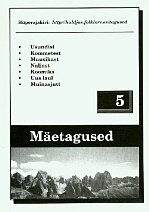Mis sealt tõuseb, soost sinine, soost sinine, maast punane?
The possible meaning of the parallel words blue and red in runo songs
Author(s): Tiiu JaagoSubject(s): Customs / Folklore
Published by: Eesti Kirjandusmuuseum
Summary/Abstract: What rises from there, blue from the swamp,/ blue from the swamp, red from the earth? The article deals with red and blue in runo songs. The usage of color words in runo songs depends on: the possibilities of the existing language; the poetics of the runo song, the regional style, the world concept at the time of the runo song's creation. The frequency of using color words depends on the song's plot (they are mostly connected with marring fantasies and puzzle songs) and inside that, on its turn, on the song type. Colors are connected with not a certain song but rather with historically developed stereotypical phrases. In a runo song they mark certain situations or phenomena. Blue and red in parallel verses hint to border situations in man's life (wedding, birth) or in nature (the border of night and day). The pair of colors has other meanings as well as it is statistically often found and semantically many-sided. Of 772 songs, color names were mentioned in 175 and all in all 37 different color words were used. Of the contemporary Estonian well-known color names were used red, blue, gray, black, white, rarely were used green and yellow from the list were absent brown, pink, violet, orange. Runo songs were recorded in the 19th century. Black, white, red, blue became the basic color names already before the 17th century. Instead of yellow, golden is often used. Green as a basic color name has been known since the middle of the 17th century and is found in runo songs only occasionally. Brown - a loan word from the 18th century - is not at all found in runo songs. From this we can not actually conclude that the stereotypical runo song expressions connected with color words had been formed before the 17th century. For example we often meet in runo songs the word gray as a basic color name, but it became a basic color only in the 18th century. At the same time, the earlier basic color name bright (`haldjas') noting green, is absent in runo songs (it is used in the contemporary meaning that marks shining, glowing or the color of a limited group of notions - i.e. the greenness of trees). The glossary of runo songs was still developing in the 18th century. Earlier color names (white, black, red, blue) give ample stereotypical expressions, red-blue in different meanings and word pictures.
Journal: Mäetagused. Hüperajakiri
- Issue Year: 1997
- Issue No: 05
- Page Range: 54-72
- Page Count: 19
- Language: Estonian

